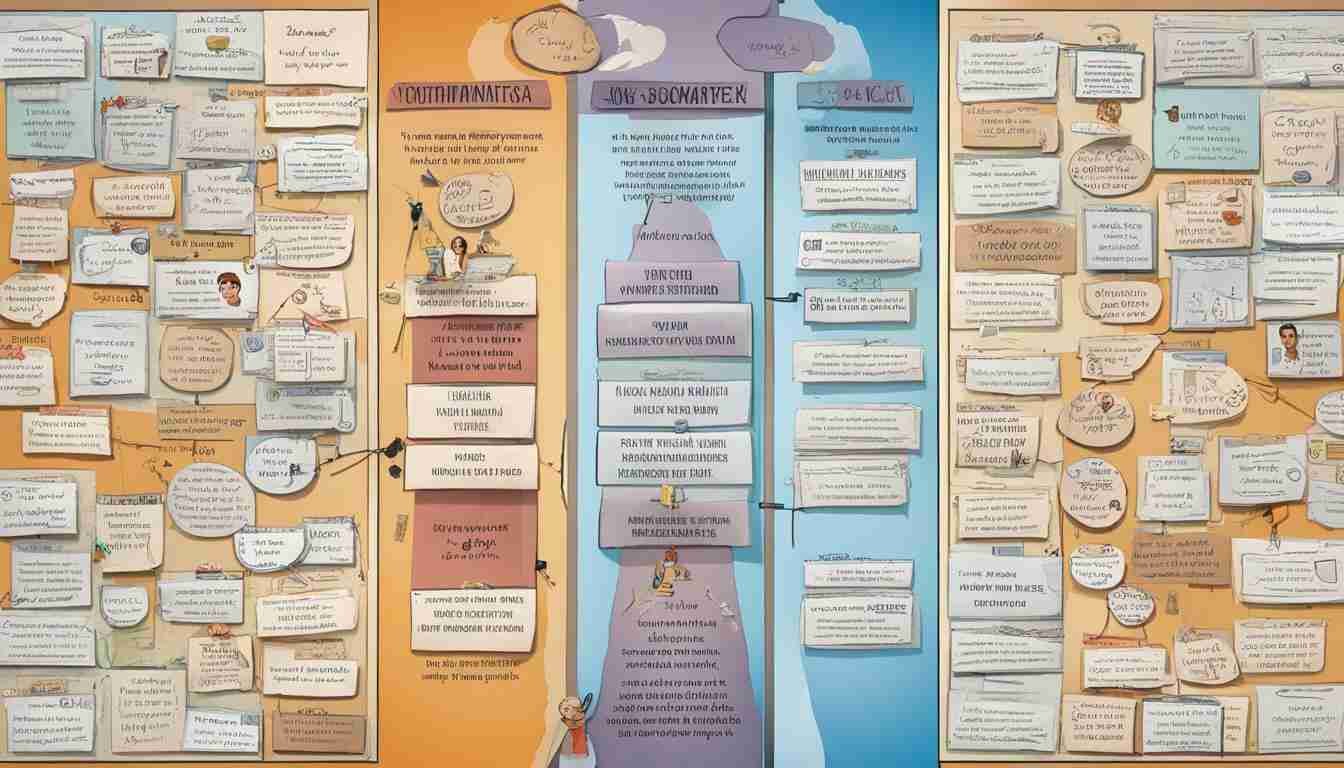When achieving our goals, we rely on motivation and drive to keep us on track. While these terms are often used interchangeably, they refer to two concepts crucial in shaping our behavior.
In this section, we will explore the key differences between motivation and drive and how they impact our ability to achieve success.
Key Takeaways
- Motivation and drive are two separate concepts that are often confused.
- Understanding the differences between motivation and drive can help us better achieve our goals.
Exploring Motivation: What Makes Us Tick?
Whether getting out of bed in the morning or striving for a promotion at work, motivation plays a crucial role in shaping our behavior and driving us toward our goals. Motivational factors can be divided into two categories: internal and external.
Internal motivation comes from within and is often linked to personal values and beliefs. It is the drive to do something based on an inherent desire or interest in the activity. On the other hand, external motivation is driven by outside factors, such as rewards or recognition from others.
Self-motivation is another crucial component of motivation. It refers to the ability to push oneself towards a goal without the need for external factors. It is often associated with intrinsic motivation, the drive to engage in an activity purely for the pleasure it brings.
Intrinsic motivation is often linked to autonomy, mastery, and purpose. When individuals have control over their work, feel competent in their abilities, and believe their work has meaning, they are more likely to be intrinsically motivated.

“Motivation is the art of getting people to do what you want them to do because they want to do it.” – Dwight D. Eisenhower
Understanding Drive: The Forces That Propel Us Forward
To fully comprehend the differences between motivation and drive, we must closely examine the driving forces that influence our actions and decisions. Drive, in essence, is the force that propels us forward, pushing us to achieve our goals and aspirations. Unlike motivation, which can be internal or external, drive is primarily an external force that stems from our environment and the people around us.
The external drive is primarily shaped by factors outside of our control, such as societal expectations, financial pressures, and the desire for social recognition. These influences can be potent and often push us to strive for success, even when faced with significant obstacles.
On the other hand, extrinsic drive comes from the rewards and incentives associated with achieving specific goals. For example, a salesperson may be driven by the prospect of a commission check, while an athlete may be motivated by the desire to win a championship.
It’s essential to note that while external and extrinsic drives can be powerful motivators, they are often short-lived and can quickly dissipate once the reward has been achieved. Long-term success and satisfaction are more likely to come from internal motivation, which we will explore in the next section.

Despite its external nature, drive can still be a significant factor in our success, particularly when combined with self-motivation and determination. By surrounding ourselves with positive influences and leveraging external forces to our advantage, we can harness the power of drive to achieve our goals and become the best versions of ourselves.
Motivation vs. Drive: Unpacking the Differences
While motivation and drive are often used interchangeably, they are two distinct concepts with unique characteristics. Motivation is an internal force that drives us towards achieving our goals. The desire to do something comes from within us, based on our passions, interests, and values. On the other hand, drive is an external force that propels us forward, often influenced by external factors such as rewards, recognition, or the fear of failure.
The main difference between motivation and drive is their source. Motivation is self-generated, while drive is extrinsic, often prompted by outside forces. Motivation is more intrinsic, comes from within, and is typically longer-lasting. On the contrary, drive tends to be more short-term and may fade when the external factor that initiated it disappears.
So, what are the key differences?
| Motivation | Drive |
|---|---|
| Internal force | External force |
| Self-generated | Influenced by outside factors |
| Long-lasting | Short-term |
It is important to note that both motivation and drive are essential in achieving our goals. While motivation provides the internal drive to pursue our passions and interests, the drive can push us to take action and overcome obstacles that hinder our progress. Together, motivation and drive work hand in hand to fuel our determination to achieve success.

Understanding the differences between motivation and drive can help us identify the source of our actions and make more informed decisions. By recognizing whether internal or external factors drive our actions, we can take steps to cultivate a more sustainable motivation and align our goals with our intrinsic values.
The Power of Determination: How Motivation and Drive Work Together
While motivation and drive are distinct concepts, they often work together to fuel our determination to achieve our goals. Motivation provides the internal desire and inspiration to pursue a goal, while drive propels us forward through external incentives and rewards.
When we have a strong sense of motivation, we are more willing to put in the effort and work required to achieve our objectives. However, motivation alone may not be enough to sustain our determination over time. This is where the drive comes in. External factors such as rewards, recognition, and pressure from others can provide the additional push we need to keep going.
On the other hand, drive without motivation may lead to a lack of fulfillment and purpose. Without a more profound sense of internal drive, we may find ourselves simply going through the motions without real passion or desire for the task.
Therefore, it is essential to cultivate both motivation and drive to achieve our goals and maintain our determination. Combining our internal drive and motivation with external incentives and rewards can create a powerful force that propels us toward success.

“Success is not final, failure is not fatal: it is the courage to continue that counts.” – Winston Churchill.
Ultimately, it is our determination that determines our success. By harnessing our motivation and drive, we can cultivate an unwavering sense of determination that enables us to overcome challenges and achieve our goals.
Conclusion
Understanding the distinction between motivation and drive is essential for anyone seeking success personally or professionally. While motivation is primarily an internal factor that drives us toward achieving our goals, the drive can be influenced by external factors such as rewards, recognition, and competition.
However, the power of determination lies in the interplay between motivation and drive. When internally motivated and stimulated by external factors, we are more likely to stay focused and committed to achieving our goals.
By recognizing the unique characteristics of motivation and drive, we can leverage them to our advantage and harness the power of determination to overcome any obstacle. Therefore, it is crucial to identify what motivates us and how external factors can be used to fuel our drive toward success.
In conclusion, understanding the differences between motivation and drive can help us better understand what drives us toward achieving our goals. By recognizing and leveraging these factors, we can unlock our full potential and succeed personally and professionally.
FAQ
Q: What is the difference between motivation and drive?
A: Motivation refers to the inner desire or enthusiasm that propels individuals to take action, while drive encompasses the external factors or forces that push individuals forward.
Q: What are some examples of motivational factors?
A: Some examples of motivational factors include personal goals, passion for a particular task or project, the desire for recognition or achievement, and the pursuit of personal growth and fulfillment.
Q: What is self-motivation?
A: Self-motivation is the ability to generate enthusiasm and drive from within oneself without relying on external rewards or incentives. It involves setting personal goals, maintaining a positive mindset, and embracing challenges and setbacks as opportunities for growth.
Q: What is the difference between internal motivation and intrinsic motivation?
A: Internal motivation refers to the desire or drive that arises within an individual, while intrinsic motivation refers to the innate enjoyment or satisfaction derived from engaging in a specific activity or task.
Q: What are some examples of driving forces?
A: Some examples of driving forces include external factors such as deadlines, competition, financial incentives, or the need to meet societal or professional expectations. These forces can exert influence and compel individuals to take action.
Q: What is extrinsic drive?
A: Extrinsic drive refers to the motivation or push that comes from external sources or rewards, such as praise, recognition, monetary compensation, or the fear of negative consequences. It often involves seeking external validation or rewards for one’s actions.
Q: How do motivation and drive differ?
A: While motivation and drive involve a desire to take action, motivation is driven by internal factors such as personal goals and passion, while external factors and forces influence drive. Motivation is more about personal enthusiasm and desire, while drive is often associated with external pressure or incentives.
Q: How do motivation and drive work together?
A: Motivation and drive work hand in hand to fuel determination and propel individuals toward achieving their goals. Motivation provides internal desire and enthusiasm, while drive harnesses external factors and forces to push individuals forward and sustain their efforts.
Q: Why is understanding the differences between motivation and drive important?
A: Understanding the distinctions between motivation and drive can help individuals better comprehend their motivations and actions. It allows for a deeper self-awareness and enables individuals to leverage internal and external factors to maximize their achievement and success.





